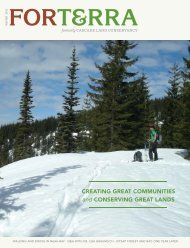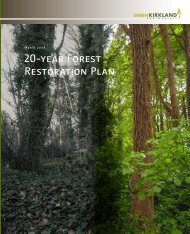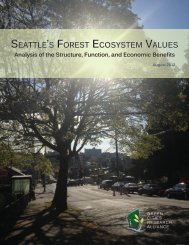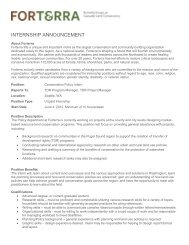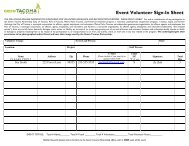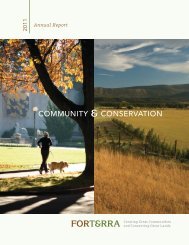Download - Cascade Land Conservancy
Download - Cascade Land Conservancy
Download - Cascade Land Conservancy
Create successful ePaper yourself
Turn your PDF publications into a flip-book with our unique Google optimized e-Paper software.
SMALL CITY SUCCESS:<br />
A Q&A with Sumner Mayor Dave Enslow<br />
8<br />
By Josh Cohen, Media Associate<br />
The City of Sumner, WA sits in the north end of Pierce<br />
County, forming a triangle with Bonney Lake to the<br />
southeast and Puyallup to the southwest. Home to almost<br />
9,500 residents, it exemplifies what it means to be a<br />
small city with unique challenges and unique advantages<br />
in our ever-changing Puget Sound Region. Forterra has<br />
worked closely with Sumner on the Orton Junction project,<br />
a development plan that would conserve 500 acres of<br />
farmland while bringing to town retail stores, residences, a<br />
farmers market, medical offices and a coveted YMCA.<br />
Sumner Mayor Dave Enslow was elected to office in 2005<br />
and began his second term in 2009. We spoke to Mayor<br />
Enslow about the challenges and successes Sumner has<br />
seen as a small city, the way Sumner’s working to stay<br />
relevant in the region, their status as rhubarb pie capital of<br />
the world and more.<br />
Let’s start with the most important question. How did<br />
you become the rhubarb pie capital of the world?<br />
Well, it’s an interesting history that includes a bit of a<br />
mystery. For over 100 years, the area around Sumner<br />
has been a huge producer of rhubarb. In 1893, Adam<br />
Knoblauch shipped the first field rhubarb to Seattle<br />
in gunny sacks. His son Henry was the first grower of<br />
commercial hot-house rhubarb in the Sumner area, starting<br />
about 1914. In the mid-20th century, one of the two<br />
rhubarb growers associations actually hired a promoter to<br />
travel across the nation to visit state fairs and encourage<br />
cooking with rhubarb. We think that somewhere in there,<br />
they came up with the “rhubarb pie capital of the world”<br />
claim. We can trace it in newspapers as far back as 1946<br />
but don’t know who actually started it. As of 2007, the<br />
USDA census shows that 27 percent of the nation’s acres<br />
growing rhubarb are still around Sumner.<br />
What do you see as the biggest challenges of our region<br />
today?<br />
Well, there are the obvious answers like employment,<br />
transportation, health care and affordable housing. Let me<br />
go with something not often discussed: unique identity.<br />
Sumner, like many cities in this region, has a proud history<br />
and distinct character. How do we preserve those unique<br />
identities so that our region is a collection of strong,<br />
independent, complete cities instead of just one big<br />
unending mass of urban sprawl?<br />
As a small city, how<br />
do those challenges<br />
impact Sumner in<br />
ways they might not<br />
impact larger cities?<br />
How has your city<br />
been dealing with<br />
those challenges?<br />
Being small, we could<br />
quickly become<br />
irrelevant on the<br />
regional scale. No one<br />
worries that Seattle will<br />
merge with Bellevue,<br />
but how many realize<br />
that Ballard used to be an independent small community?<br />
We deal with it by doing what we can to be strong and<br />
relevant so that when it does make sense to partner with<br />
other cities we are a valuable, if small, partner.<br />
Conceptually, we asserted our independence by bringing<br />
back the Rhubarb Pie Capital celebration. It’s cute and fun,<br />
but it also distinctly defines us. On a more serious side, we<br />
moved forward to build Orton Junction. That one project<br />
brings us health care, a gathering place, a farmer’s market<br />
and additional retail options that residents are currently<br />
seeking in Tacoma or even King County. Critics of the<br />
project say our residents should just travel to Parkland<br />
for new jobs and to Kent for retail and to Puyallup for<br />
health care. I like partnering and visiting our neighbors,<br />
but wouldn’t it make more sense to encourage Sumner to<br />
bring back health care, retail, recreation and jobs here so<br />
that people could access them by walking or biking instead<br />
of a long trip in a car?<br />
Alternatively, how do you think Sumner can be part of<br />
the solution? One example that comes to mind is your<br />
embrace of the Sounder rail line and providing parkand-ride<br />
parking.<br />
Sumner’s vision is to set the standard of excellence for a<br />
progressive small town, and that’s how we can be part of<br />
the solution. There are lifestyle options here that are old<br />
but also popular again. On Main Street, you can still visit<br />
the eye doctor, the bank, the pharmacy, City Hall, a few<br />
restaurants and great shops within a two-block walk. No<br />
car travel required. I love riding my bike the two miles from<br />
my house to City Hall, and I’m 70, so if I can do it, anyone<br />
can do it.<br />
FORTERRA.ORG<br />
Mayor Dave Enslow. Photo courtesy of the City of Sumner



